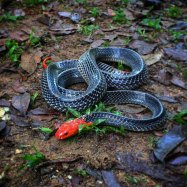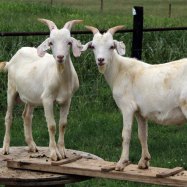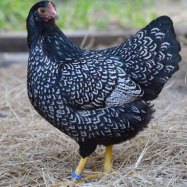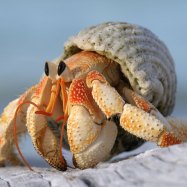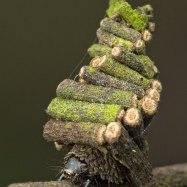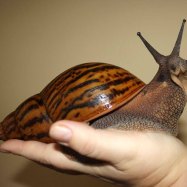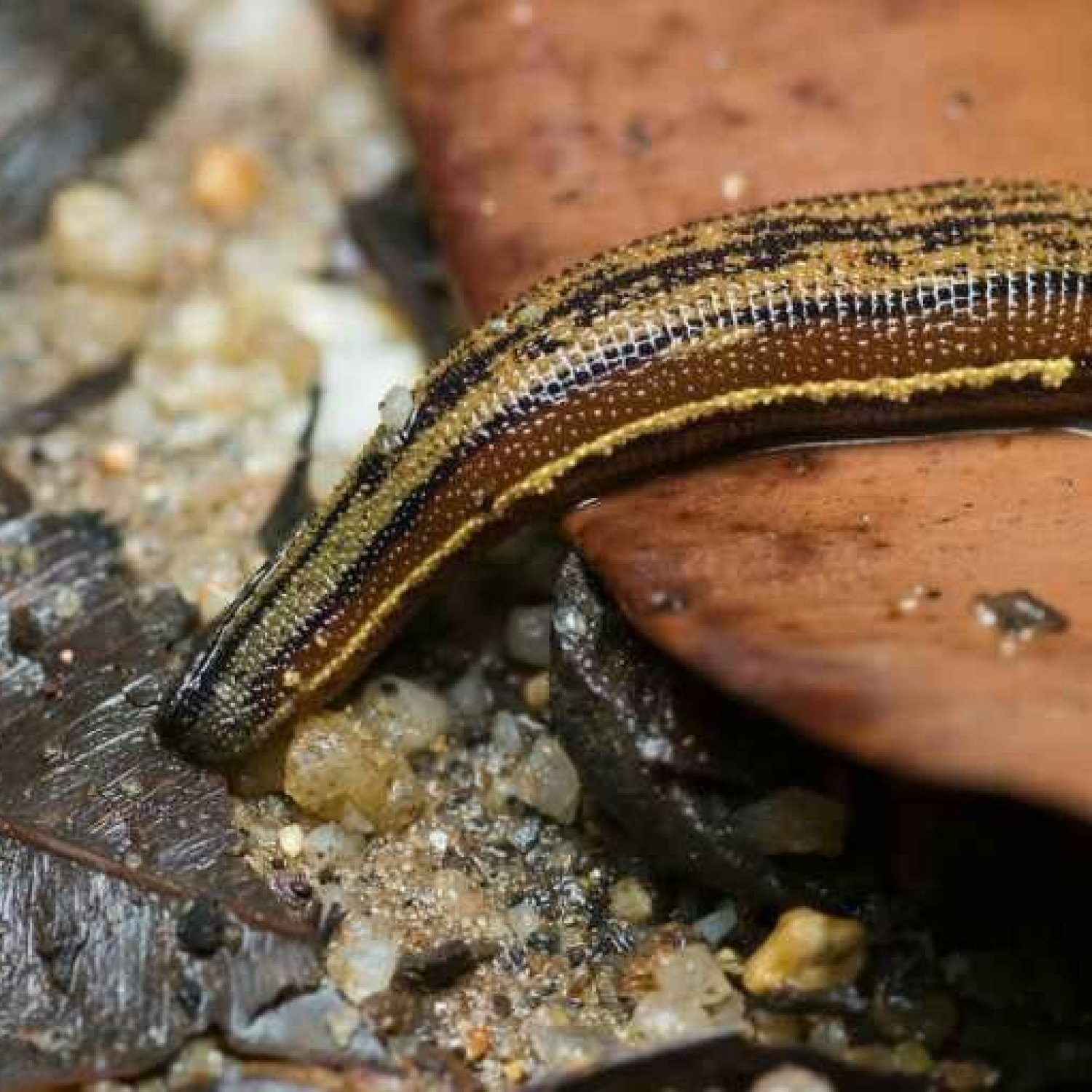
Leech
1 cm to 20 cm
Leeches are fascinating creatures that can be found in various aquatic environments, from lakes to streams. These worm-like animals can range in size from just 1 cm to a whopping 20 cm! They belong to the Hirudinidae family and are known for their blood-sucking abilities. But don't worry, they only feed on small animals and play an important role in keeping water ecosystems balanced. So next time you see a leech, appreciate its role in nature! #animals #aquaticlife #leeches
Animal Details Summary:
Common Name: Leech
Kingdom: Animalia
Habitat: Freshwater
Introduction
In a world filled with millions of animal species, some stand out due to their distinctive and often overlooked characteristics. One such creature is the leech, a seemingly simple and unassuming animal that hides a fascinating and complex world within its worm-like body. Despite their reputation as blood-sucking pests, leeches are actually an integral part of the ecosystem and have been used for various purposes throughout history. In this article, we will explore the world of leeches, from their physical characteristics to their unique feeding methods and global distribution Leech.The Classification of Leeches
At first glance, leeches may seem like just another type of worm, but they actually belong to the class Clitellata in the phylum Annelida. This class includes around 10,000 species of segmented worms, including earthworms and freshwater worms. Within the class Clitellata, leeches belong to the order Hirudiniformes and the family Hirudinidae. Their scientific name, Hirudinea, derives from the Latin word for “bloodsucker,” indicating their characteristic feeding behavior.Physical Characteristics
The body of a leech is cylindrical and elongated, with the average length ranging from 1 cm to 20 cm. They have a soft and flexible body with a distinct sucker at each end. The anterior sucker, located at the front end of the leech, is used for attachment and feeding, while the posterior sucker is used for movement. The body color of a leech can vary from dark brown to black, and they often have stripes or spots of lighter colors. This dark coloration helps them blend into their environment, making them harder to detect by potential predators Liger.Habitat and Distribution
Leeches are found in freshwater habitats all around the world, including lakes, ponds, rivers, and streams. They prefer to live in slow-moving or stagnant water, where they can easily attach themselves to vegetation or animals passing by. Leeches are also commonly found in wetlands and swamps, where the conditions are perfect for their survival. They can thrive in both tropical and temperate climates, and some species can even survive in cold waters.Feeding Behavior
One of the most distinctive features of leeches is their feeding behavior. Leeches are hematophagous, which means they feed on the blood of other animals. However, not all leeches feed on blood. Some species are predatory and feed on other invertebrates, while others are herbivores and feed on plant matter. The majority of leech species, however, are bloodsuckers and feed on the blood of vertebrates, including fish, amphibians, reptiles, birds, and mammals.Unique Feeding Method
Unlike most other animals, leeches do not have jaws or teeth. Instead, they have a specialized mouth with three sharp teeth arranged in a triangular pattern. When a leech finds its prey, it attaches itself to their skin using its anterior sucker. It then uses its teeth to make a small incision and releases an anticoagulant substance into the wound to prevent the blood from clotting. The leech then sucks up the blood, which can sometimes make up to 10 times its own body weight. Once it is full, the leech detaches itself and falls off its host, leaving a small, painless mark.Roles in the Ecosystem
Despite their reputation as parasites, leeches play an important role in the ecosystem. They help regulate the population of their prey and are also a food source for other animals, such as fish and birds. Their presence in freshwater habitats helps to keep the ecosystem balanced and healthy. In fact, some studies have shown that leeches can even help prevent the spread of diseases by feeding on sick or infected animals.Uses in Medicine
Leeches have been used for medicinal purposes since ancient times, and their therapeutic properties have been documented in ancient Egyptian, Greek, and Roman texts. In modern medicine, leeches are still used to treat various health conditions, particularly in the field of plastic and reconstructive surgery. During these procedures, leeches are used to drain excess blood from the affected area and promote the growth of new blood vessels, speeding up the healing process.Leeches in History and Culture
Leeches have also played a significant role in human history and culture. In ancient times, they were used in bloodletting practices to balance the body's humors and treat various illnesses. They were also believed to have medicinal properties and were used to treat anything from headaches to mental disorders. In Indian and Chinese cultures, leeches are still used in traditional medicine to treat a wide range of ailments. In some regions of Africa, leeches are also used for their supposed healing properties.Challenges Facing Leeches
Despite their fascinating abilities and uses, leeches are facing various challenges in today's world. One of the biggest threats to their survival is the destruction of their natural habitats. As freshwater sources become increasingly polluted and depleted, the population of leeches is declining. Additionally, the use of pesticides and other chemicals in agriculture and other industries can harm leeches and their prey, leading to a decrease in their population.In Conclusion
Leeches may not be the most glamorous or well-loved creatures, but they play a vital role in the ecosystem and have fascinated humans for centuries. From their unique feeding method to their use in medicine and cultural significance, leeches are more complex and interesting than most people realize. As we continue to learn more about these incredible animals, it is important to take steps to protect their habitats and preserve their place in the natural world. So, the next time you come across a leech, remember the unseen hunter that it is and appreciate its place in the grand scheme of things.

Leech
Animal Details Leech - Scientific Name: Hirudinea
- Category: Animals L
- Scientific Name: Hirudinea
- Common Name: Leech
- Kingdom: Animalia
- Phylum: Annelida
- Class: Clitellata
- Order: Hirudiniformes
- Family: Hirudinidae
- Habitat: Freshwater
- Feeding Method: Hematophagous
- Geographical Distribution: Worldwide
- Country of Origin: N/A
- Location: Aquatic environments
- Animal Coloration: Dark brown to black
- Body Shape: Worm-like
- Length: 1 cm to 20 cm

Leech
- Adult Size: Varies depending on species
- Average Lifespan: 1-2 years
- Reproduction: Sexual
- Reproductive Behavior: During mating, leeches form a temporary union and exchange sperm
- Sound or Call: None
- Migration Pattern: N/A
- Social Groups: Solitary
- Behavior: Parasitic, attaching to host animals and feeding on their blood
- Threats: Habitat loss, pollution, and overcollection
- Conservation Status: Varies depending on species
- Impact on Ecosystem: Regulate host populations, can transmit diseases
- Human Use: Medical and scientific research
- Distinctive Features: Suckers at both ends of their body
- Interesting Facts: Leeches have been used for medicinal purposes for centuries
- Predator: Some fish species and aquatic birds

Hirudinea
The Fascinating World of Leeches: Nature's Hidden Helpers
When we think of leeches, the first images that come to mind may be creepy, blood-sucking creatures attached to our bodies. However, there is much more to these slimy invertebrates than meets the eye. Leeches have been around for millions of years and are found in various habitats all over the world. While they may have a bad reputation, these creatures play important roles in the ecosystem and have even been used for medicinal purposes for centuries PeaceOfAnimals.Com.So, let's take a closer look at these creatures and discover what makes them unique, their behaviors, threats they face, and their impact on the ecosystem.
Adult Size and Average Lifespan
Leeches come in various sizes, ranging from a few millimeters to over 1 foot in length, depending on the species. Some species, such as the Amazon giant leech, can reach up to 18 inches in length, while others, like the North American medicinal leech, are only a few inches long.
Their lifespan also varies depending on the species. On average, leeches live for 1-2 years, but some species have been known to live up to 10 years in captivity.
Reproduction and Reproductive Behavior
Like most animals, leeches reproduce sexually. However, their reproductive behavior is quite unique. During mating, leeches form a temporary union, attaching to each other with their suckers at both ends of their body. They then exchange sperm, and the female lays eggs, which are kept in a cocoon until they hatch Lyrebird.
One interesting fact about leeches is that they are hermaphrodites, meaning they have both male and female reproductive organs. This allows them to mate with any other leech they come across, as they do not have to search for a specific gender to reproduce.
Sound or Call and Migration Pattern
Unlike many other animals, leeches do not produce any sound or call. They are also unable to move very far from their habitats due to their need for a moist environment. Therefore, they do not have a migration pattern, and their movements are mostly limited to finding food.
Social Groups and Behavior
As solitary creatures, leeches do not form social groups or have any social interactions. They are mostly nocturnal, and during the day, they can be found hiding in damp areas, such as under rocks or in the mud.
Their behavior is quite simple and revolves around finding a host to feed on. Leeches are parasitic, meaning they attach themselves to host animals, ranging from small insects to larger mammals. They use their suckers to hold onto the host's skin and then secrete an anticoagulant substance, which prevents the host's blood from clotting. This way, they can feed on the host's blood for several hours to days, depending on their size and species.
Threats and Conservation Status
Unfortunately, leeches face many threats in their natural habitats. Habitat loss due to pollution and human activities is one of the biggest threats to their survival. As they are mostly found in aquatic environments, water pollution can have a severe impact on their population.
Moreover, overcollection by humans for medicinal and scientific research is also a major threat to leeches. In some parts of the world, leeches are considered a delicacy and are over-harvested, leading to a decline in their numbers. This is especially concerning as some species of leeches have specific habitats and are only found in certain areas, making them more vulnerable to extinction.
The conservation status of leeches varies depending on the species and their geographic locations. Some species are classified as vulnerable, endangered, or even critically endangered.
Impact on Ecosystem
Despite their negative reputation, leeches play an essential role in regulating host populations. By feeding on the blood of animals, they can help keep the host population in check, preventing diseases and overpopulation. They also act as indicators of the health of their habitats, as their numbers decrease in polluted or unhealthy environments.
However, like most animals, leeches can also have a negative impact on the ecosystem. They can transmit diseases to their hosts, such as bacteria and parasites. This is a cause for concern, especially in areas where leech populations are high, and diseases can spread easily.
Human Use
For centuries, leeches have been used for medicinal purposes. In ancient times, they were believed to cure numerous ailments and were used to balance the body's humors. With advancements in science and medicine, leeches have been found to have medicinal properties, such as their ability to improve blood circulation and prevent blood clots.
Today, leeches are still used in medical treatments, particularly in plastic and reconstructive surgery. These creatures are also used in scientific research, as they have been found to have anti-inflammatory and anti-coagulant properties that can aid in the development of new medicines.
Distinctive Features and Interesting Facts
One of the most distinctive features of leeches is their two suckers, one at the front and one at the rear of their body. These suckers are used for moving, attaching to their hosts, and exchanging sperm during mating. Some species also have a proboscis, a retractable mouthpart used for feeding.
One interesting fact about leeches is that they have been used for medicinal purposes for centuries. In the 19th century, leeches were widely used in Europe and North America to treat various ailments, from headaches to gout. This practice, called leeching, was eventually abandoned with the discovery of more effective medicines. However, leeches are still used for medical purposes in some traditional and alternative medicine practices.
Predators
Despite their ability to attach themselves securely to hosts, leeches do have natural predators. Some fish species, such as the clown loach and giant piranha, feed on leeches. Aquatic birds, such as ducks and herons, also consume leeches as part of their diet.
In Conclusion
In conclusion, leeches are fascinating creatures with unique characteristics and behaviors. While they may have a negative reputation, they play important roles in the ecosystem, and their medicinal properties have been used for centuries. As human activities threaten their habitats, it is essential to raise awareness about the importance of conserving these creatures and their natural habitats. So, the next time you come across a leech, remember the vital role it plays in nature and marvel at its hidden talents.

Introduction
Disclaimer: The content provided is for informational purposes only. We cannot guarantee the accuracy of the information on this page 100%. All information provided here may change without prior notice.


